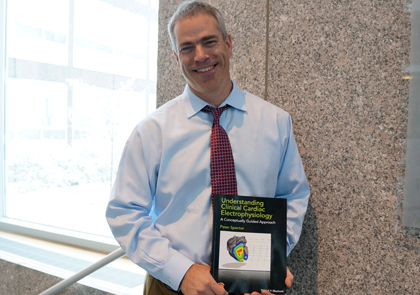Vermont electrophysiologist Peter Spector, M.D., has uncovered a wealth of new information about why the heart’s electrical system works the way it does – or goes awry. And like a guy with a great joke, he feels compelled to share it with others.

Peter Spector, M.D., Professor of Cardiovascular Medicine, with his book "Understanding Clinical Cardiac Electrophysiology" (Photo: UVM COM Design & Photography)
Vermont electrophysiologist Peter Spector, M.D., has uncovered a wealth of new information about why the heart’s electrical system works the way it does – or goes awry. And like a guy with a great joke, he feels compelled to share it with others. His new book – titled Understanding Clinical Cardiac Electrophysiology: A Conceptually Guided Approach and published in May 2016 by Wiley-Blackwell – isn’t like most textbooks that provide pragmatic tips and answers to common questions.
To him, those texts are like the old adage about giving a man a fish so he can eat for a day or teaching him to fish so he can eat for a lifetime. Spector doesn’t want a bunch of fish handed to him. He wants to know how the fish swim, where they go, what he needs to do to catch them.
A University of Vermont professor of medicine and director of electrophysiology at the UVM Medical Center, Spector has spent about 25 years studying the electric signals and flow of electrical current that spurs the heart to pump. As a specialist in atrial fibrillation (A-fib), the most common form of heart rhythm disorder, Spector has developed a deep understanding of this process so that he can better treat patients, he says.
Spector calls it a cohesive approach to a complex system. Electrophysiology is not a linear system, in which one change or action leads to the next change, which leads to the next – a chain reaction. In a complex system, one change leads to multiple changes in multiple directions, and those changes in turn cause multiple reactions in multiple places.
“I sort of put it all together in a way that makes sense to me,” Spector says. “The book is trying to tell the complex story of the mechanisms of the heart.”
The book is a key component of Spector’s two-day intensive course, “Foundations of Electrophysiology,” which he launched about eight years ago. He teaches it all over the world, primarily to cardiology fellows training to become electrophysiologists.
The biggest challenge to understanding and explaining electrophysiology, Spector says, is that doctors cannot see the process in action any more clearly than someone can see the electricity flowing through the wires into their homes. While putting together his course plan, Spector came up with the idea of using computer software to provide that picture.
He teamed up with UVM colleague Jason Bates, Ph.D., professor of medicine and an expert in bioengineering and physiologic modeling, to create a three-dimensional computer model of the heart’s electrical system. It shows the electric potential field, or voltage, around the heart and color-coded changes in voltage and current.
The computer model is deeply integrated into Spector’s course, which he describes as “drinking from a fire hose” – an overload of information. He spent years developing material that students could take home following the course; this effort turned into Understanding Clinical Cardiac Electrophysiology. In addition to Wiley’s distribution of the book, Spector started a company, called Visible EP (Electrophysiology), to offer the computer modeling software to specialists who want to learn electrophysiology or use it for their own research.
“It became clear that this was a really powerful teaching tool, and people needed it,” he says.
Now, he is developing a similar course on atrial fibrillation, also using modeling software, and plans to produce a companion book as well. The electrophysiology model has led to Spector’s development of a new electrode design and mapping system to track the specific characteristics of A-fib in individual patients, so as to better target treatment.